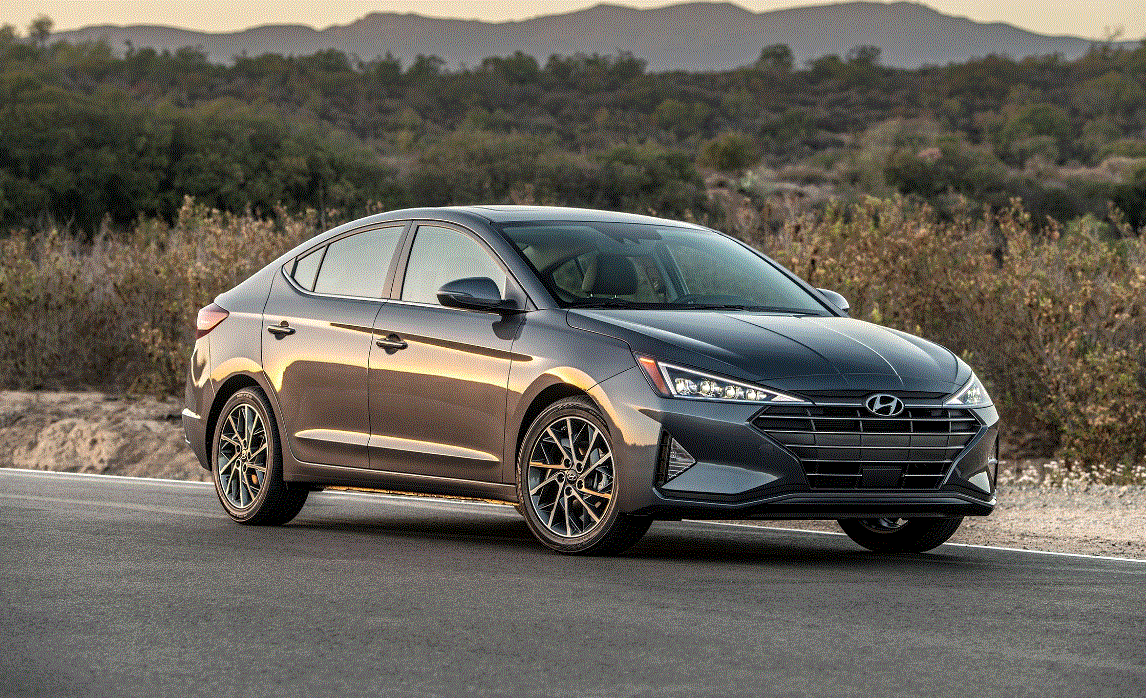2019 Hyundai Elantra Instrument Cluster | Display Features
The centrepiece of the dashboard display on the 2019 Hyundai Elantra is an elegant and intuitive instrument cluster. The instrument cluster, which perfectly balances style and functionality, gives drivers quick access to vital information and improves the driving experience in general. The 2019 Hyundai Elantra instrument cluster features a bright, contemporary display that highlights several important metrics, such as engine RPM, speed, and fuel level. The layout’s ease of use guarantees that drivers can quickly obtain important information while keeping their eyes on the road. The instrument cluster, which combines digital and analog components, is a harmonious blend of traditional style and modern technology.
In summary, the 2019 Hyundai Elantra’s instrument cluster not only provides important information in an understandable and efficient manner, but it also elevates the overall interior design with a hint of refinement. The dashboard display, which combines style, functionality, and safety features, is a testament to Hyundai’s dedication to giving owners of this model a smooth and enjoyable driving experience.
2023 Hyundai Elantra Specs, Price, Features, Milage (Brochure)
Instrument Cluster


-
Tachometer
-
Speedometer
-
Engine coolant temperature gauge
-
Fuel gauge
-
Warning and indicator lights
-
LCD display (including Trip computer)
The actual cluster in the vehicle may differ from the illustration.


-
Tachometer
-
Speedometer
-
Engine coolant temperature gauge
-
Fuel gauge
-
Warning and indicator lights
-
LCD display (including Trip computer)
The actual cluster in the vehicle may differ from the illustration.
Instrument Cluster Control
Adjusting instrument cluster illumination

When the vehicle’s parking lights or headlights are on, press the illumination control button to adjust the brightness of the instrument panel illumination.
When pressing the illumination control button, the interior switch illumination intensity is also adjusted.
WARNING
Never adjust the instrument cluster while driving. Doing so could lead to driver distraction which may cause an accident and lead to vehicle damage, serious injury, or death.

-
The brightness of the instrument panel illumination is displayed.
-
If the brightness reaches the maximum or minimum level, a chime will sound.
Gauges
Speedometer

The speedometer indicates the speed of the vehicle and is calibrated in miles per hour (mph) and/or kilometres per hour (km/h).
Tachometer

The tachometer indicates the approximate number of engine revolutions per minute (rpm).
Use the tachometer to select the correct shift points and to prevent lugging and/or over-revving the engine.
NOTICE
Do not operate the engine within the tachometer’s RED ZONE. This may cause severe engine damage.
Engine coolant temperature gauge

This gauge indicates the temperature of the engine coolant when the ignition switch or Engine Start/Stop button is ON.
NOTICE
If the gauge pointer moves beyond the normal range area toward the “H” position, it indicates overheating that may damage the engine.
Do not continue driving with an overheated engine. If your vehicle overheats, refer to “If the Engine Overheats” in Chapter 6.
WARNING
Never remove the radiator cap or reservoir cap when the engine is hot. The engine coolant is under pressure and could severely burn. Wait until the engine is cool before adding coolant to the reservoir.
Fuel gauge

This gauge indicates the approximate amount of fuel remaining in the fuel tank.
Information
-
The fuel tank capacity is given in chapter 8.
-
The fuel gauge is supplemented by a low fuel warning light, which will illuminate when the fuel tank is nearly empty.
-
On inclines or curves, the fuel gauge pointer may fluctuate or the low fuel warning light may come on earlier than usual due to the movement of fuel in the tank.
WARNING
Running out of fuel can expose vehicle occupants to danger. You must stop and obtain additional fuel as soon as possible after the warning light comes on or when the gauge indicator comes close to the “E (Empty)” level.
NOTICE
Avoid driving with an extremely low fuel level. Running out of fuel could cause the engine to misfire, damaging the catalytic converter.
Odometer

The odometer indicates the total distance that the vehicle has been driven and should be used to determine when periodic maintenance should be performed.
Range

-
The range is the estimated distance the vehicle can be driven with the remaining fuel.
-
If the estimated distance is below 1 mi. (1 km), the trip computer will display “—-” as range.
Information
- If the vehicle is not on level ground or the battery power has been interrupted, the range function may not operate correctly.
- The range may differ from the actual driving distance as it is only an estimate of the available driving range for the vehicle and driving conditions.
- The trip computer may not register additional fuel if less than 1.6 gallon (6 liters) of fuel are added to the vehicle.
- The range may vary significantly based on driving conditions, driving habits, and the condition of the vehicle.
Outside temperature gauge
This gauge indicates the current outside air temperatures by 1°F (1°C).
– Temperature range : -40°F ~ 140°F (-40°C ~ 60°C)
The outside temperature on the display may not change immediately like a general thermometer (to avoid distracting the driver).
To change the temperature unit from°F to °C or °C to °F:

For conventional cluster:
- Press the TRIP button for more than 5 seconds on the steering wheel.

For supervision cluster:
- Go to the User Settings Mode ➝ Other ➝ Temperature Unit. Select your desired unit.
For vehicles equipped with Automatic Climate Control, you can also:
- Press the AUTO button while pressing the OFF button on the cli-mate control unit for 3 seconds
Both the temperature unit on the cluster LCD display and the climate control screen will change.
Transmission Shift Indicator
Manual transmission shift indicator (if equipped)

This indicator informs which gear is desired while driving to save fuel.
-
Shifting up: ▲2, ▲3, ▲4, ▲5, ▲6
-
Shifting down: ▼1, ▼2, ▼3, ▼4, ▼5
For example
- 3 Indicates that shifting up to the 3rd gear is desired (currently the shift lever is in the 2nd or 1st gear).
- 3 Indicates that shifting down to the 3rd gear is desired (currently the shift lever is in the 4th, 5th, or 6th gear).
When the system is not working properly, the indicator is not displayed - 3 Indicates that shifting up to the 3rd gear is desired (currently the shift lever is in the 2nd or 1st gear).
- 3 Indicates that shifting down to the 3rd gear is desired (currently the shift lever is in the 4th, 5th, or 6th gear).
When the system is not working properly, the indicator is not displayed
Automatic transmission and dual-clutch transmission shift indicator (if equipped)

This indicator displays which auto-matic transmission shift lever is selected.
-
Park : P
-
Reverse: R
-
Neutral: N
-
Drive: D
-
Sports Mode
-
Auto Transmission: 1, 2, 3, 4, 5, 6
-
Dual Clutch Transmission: 1, 2, 3, 4, 5, 6, 7
-

Shift indicator pop-up (if equipped)
The pop-up displays the current gear position selected for 2 seconds (P/R/N/D).
The shift indicator pop-up function can be activated or deactivated from the User Settings mode in the cluster LCD display.
FAQs
In addition to trip information, the instrument cluster shows important data like speed, fuel levels, and engine RPM.
The 2019 Hyundai Elantra’s instrument cluster is customizable, letting drivers select and order the data they wish to view.
The instrument cluster does, in fact, combine analog and digital components for a contemporary yet timeless look.
For a more thorough driving experience, the display has a trip computer, navigation support, and real-time vehicle diagnostics.
The instrument cluster covers features like tire pressure monitoring and collision avoidance systems and offers significant alerts and warnings.
Yes, drivers can view navigation information on the 2019 Hyundai Elantra instrument cluster, reducing the need to look away from the road.
Various display themes to accommodate personal preferences may be available depending on the trim level.
The instrument cluster’s user-friendly design makes sure that drivers can quickly and easily access important information without being distracted.
In order to notify drivers of maintenance requirements and guarantee prompt attention to the vehicle’s health, the display does indeed offer real-time vehicle diagnostics.
A lot of models have a night mode that changes the display’s color and brightness to make it easier to see in low light.
In order to help drivers make more informed decisions for more fuel-efficient driving, the instrument cluster may offer information on fuel efficiency.
The instrument cluster improves the overall driving experience by centrally locating important information and features, making driving more convenient for the driver.
Absolutely, drivers can navigate through the instrument cluster menus without being unduly distracted thanks to the user-friendly interface.
Certain models might have a speed warning function that notifies drivers if they go over a predetermined speed limit.
Some models, depending on the trim level and model, might have smartphone connectivity options to incorporate extra features into the instrument cluster display.
Useful Links
View Full PDF: Hyundai Elantra 2019 User Manual|Auto User Guide
2023 Hyundai Elantra Specs, Price, Features, Milage (Brochure)


